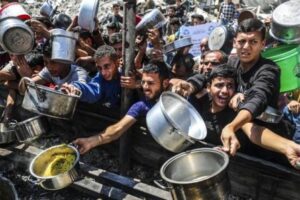An October 1 article on this website argued that the Israeli state was engaged in a major rebooting of the campaign to eliminate all Palestinians from the area that Israel claimed as its historic homeland. Unfortunately, this perspective has been born out—with a vengeance. The purpose of today’s article is to examine the latest developments in this growing offensive.
Gaza: The assassination of Sinwar
The most important recent event in Gaza is not the October 17 assassination of Hamas leader Yaha Sinwar. Even though serious bourgeois newspapers have gone into hysterical overdrive about Sinwar’s killing, it’s not going to fundamentally change the situation. Of course, the killing of a central leader is a serious blow to Hamas. But Hamas is a mass organization; other leaders will be selected. Its popular base has not been destroyed. On the contrary, its reputation as the main fighting organization of the Palestinian resistance has grown in recent months. Speculation that Israel is now going to sue for peace is completely undermined by the sharp escalation in Lebanon and impending attack on Iran. It may well be that one day, Israel will conclude that it has accomplished as much as it can in the current situation and cease the present campaign for a certain period. But that day is not today.
The General’s Plan
Instead, the most important event in Gaza is the beginning of the implementation of the General’s Plan in northern Gaza. The General’s Plan was formulated by retired Major General Giora Eiland. The plan is quite straightforward: evict all Palestinians from northern Gaza, build a military barrier across central Gaza at the Netzarim Corridor, and then declare northern Gaza a free-fire zone where all inhabitants would be military targets. This would lead to the “de- Palestinianization” of the area.
Eiland is frank in his genocidal objectives. He said “The fact that we are breaking down in the face of humanitarian aid to Gaza is a serious mistake… Gaza must be completely destroyed: terrible chaos, severe humanitarian crisis, cries to heaven…” Parenthetically, Eiland is thought to be on the center-left of the Israeli political spectrum. He opposed Netanyahu in last year’s constitutional crisis. The fact that such a monster can be considered center-left shows how far right Israeli politics have swung!
There is every reason to believe that some version of the General’s Plan is being implemented today. Aid shipments into Gaza have been sharply curtailed. 1.9 million Gaza residents are now refugees. To get a sense of proportion, there were 2.1 million inhabitants before the war. This means that 90% of the population has been forced from their homes. Every day we read of new missile attacks on schools and hospitals. There have now been 43,257 Palestinians killed. Adding in those who died from starvation, disease, lack of medical care, etc. the figure is approaching two hundred thousand. Israel has made real progress towards achieving its objectives in Gaza.
Lebanon
Lebanon is obviously the main new front in the Israeli offensive. This campaign has two motivations. The first is to rekindle momentum for the ethnic cleansing of Gaza and the West Bank. The second is to severely weaken Hezbollah. This is not primarily about ceasing Hezbollah’s low level rocket attacks that have prompted some evacuations in northern Israel. It’s much more about using the present political moment to advance on regional strategic aims as well as Zionist territorial objectives. Degrading Hezbollah on the northern front not only weakens a potential military threat, but it also sends a message to Hezbollah’s sponsor, Iran. For a long time, Tel Aviv has seen Tehran as its greatest long-term enemy. Once we have Israel’s regional strategic goals in mind, current events begin to fall into place.
The Israeli offensive in Lebanon has taken three forms. The first is terror. This can be seen in the assassination of Nasrallah, the pager and walkie-talkie bombs, and the targeted assassinations. The second form is the ground offensive. Troops have entered Lebanon on a broad front from Naqoura to Odaisseh, basically the whole southern border of Lebanon. United Nations UNIFIL peacekeeping forces have come under fire on numerous occasions. It’s still unclear if the aim is to create a permanent buffer zone or to inflict severe damage on Hezbollah before retreating to the Blue Line.
The third aspect of the offensive is the aerial bombardment. Its results have been devastating. It’s estimated there are now one million refugees in a country of five million. At least 2,418 people have been killed. Dahiya in the southern suburbs of Beirut have been one of the main targets. This is because it is seen as one of Hezbollah’s main bases of support. The bombing has not been confined to Hezbollah controlled areas. In fact, Christian areas in the north have been hit. Exacerbating sectarian conflicts between Hezbollah and Sunnis and Christians may well be one of the aims of Israeli strategy. The objective would be to get other sectors of Lebanese society to blame Hezbollah for “bringing the war to them”. Then Hezbollah would have to deal with facing rearguard actions in Lebanon as well as the IDF in the south.
Iran
The Israeli government would like to use the current tornado of chaos to strike some real blows against Iran. Israel has been constantly provoking the Iranian government, leading many observers to believe that they wished to instigate a war with the Islamic Republic. The latest round in the confrontation between the countries was the October 1 Iranian missile salvo against Israel. Little damage was caused by this attack. The world is now waiting for the Israeli response. Supposedly, Israel has agreed to the US demand that oil-producing facilities and nuclear plants be excluded from the target list. The order to exempt the nuclear plants is obvious enough. An uncontrollable Chernobyl type of situation could easily take place. The order to exempt oil-production is a wonderful example of the logic of capitalism. The United States supports Israel against its Middle Eastern foes. However, it does not want oil production disrupted as this would increase oil prices on the world market. So, Iran should be attacked in a way that does not threaten capital accumulation!
West Bank
The dramatic events of the past days in Gaza and Lebanon should not take our attention away from the West Bank. Sooner or later, Israel will apply its Gaza tactics to the West Bank. Home to three and a quarter million Palestinians, the West Bank will have to be ethnically cleansed if the “Judaization of the Galilee” is to take place. Today, the IDF does as it wishes in this area. There are 700,000 Israeli settlers in the West Bank and East Jerusalem. Armed settler gangs rampage like Quantrill’s Raiders in the Bleeding Kansas of the 1850s. They do as they please, engaging in racist attacks with impunity. Theft of Palestinian crops is common. Over the past year, 757 Palestinians, including 165 children, have been killed on the West Bank. Over 6,250 have been injured. These horrific figures are only a harbinger of what the New Nakba has in store for the West Bank.
One, two, you know what to do
Pulling together the events of the past few weeks, we see that the Israeli leadership has made a conscious decision to up the ante in its four main “areas of operations”: Gaza, Lebanon, Iran, and the West Bank. It hopes to create a new political situation in the Middle East with a thoroughly devastated Gaza, a severely downgraded Hezbollah, a chastened Iran, and the grounds laid for a future campaign in the West Bank.
There is no need for a long conclusion to this article. I’ve always liked the clarity of the count-down sometimes used in rock and blues, “One, two, you know what to do”. Well, Marxists know exactly what to do today—march in the streets in solidarity with Palestine!



